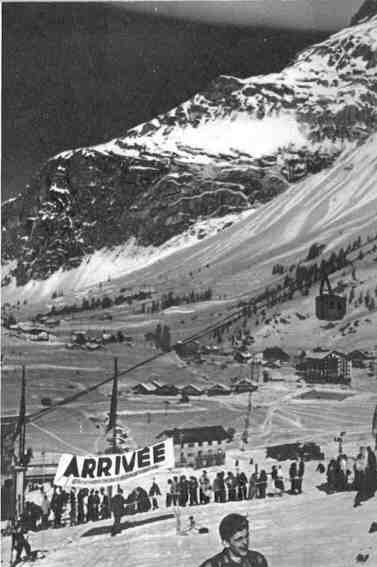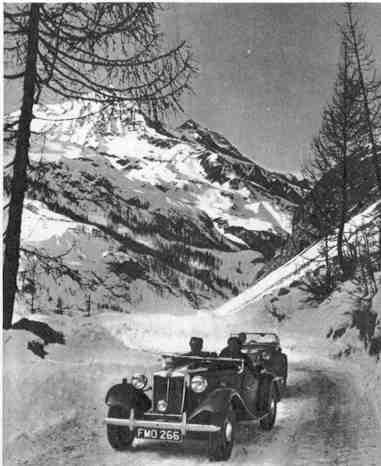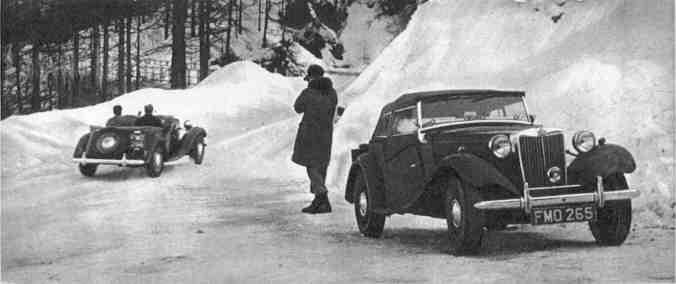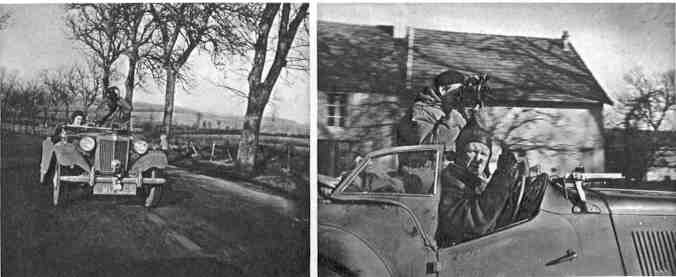The speed was
pushed up until the car was holding, a speedometer reading Of 82½ m.p.h.,
and the rev counter needle was round to 5,500. A speedometer and rev counter
calibration had already shown an optimism of about 8 per cent, but after making
due allowance for this it was apparent that we were maintaining a cruising
speed, of 70-75 m.p.h. and confirmation soon came as we logged the times
through journey, Auxerre, Avallon, and Saulieu to Arnayéle-Duc. The
roads were wet, the traffic was fairly heavy by French standards and we were
twice brought down to second gear in delays behind heavy lorries, but when we
stopped for petrol at Arnay the 108.5 miles from Sens had been covered in 105
minutes, giving an average speed of 62 m.p.h.
The speed through the last section from Saulieu
was reduced by preparations to film the petrol stop of the second car at Arnay
and the average taken over the section from Sens to Saulieu was even better,
with a distance of 91.5 miles covered in 87 minutes at an average of 63.1
m.p.h. The second car covered the stretch Fontainebleau to Avallon, 99.6 miles,
in 98 minutes, averaging 61 m.p.h.
My car, which was the one used for The
Autocar Road Test, had been run in the morning with head and side-screens
erected but the sidescreen on the driver's side had been omitted. At the lunch
stop at Chagny, this screen was put into place and the complete enclosure of
the car seemed to have an appreciable effect on speed. We are accustomed to the
fact that closed cars are faster than open ones, but it looks as though the
eddies caused by the absence of sidescreens may also have a measurable effect.
| on Skis - and TD's:continued |
At all events, the car which had covered several flying kilometres in the
morning in times between 29 and 30 sec now proved capable, heavily laden as it
was with photographers' equipment, of spacing the kilometre posts at intervals
of less than 29 Sec, and covered one level stretch past an aerodrome in 28.4
sec, giving an average speed of 78.8 m.p.h.
As darkness fell there were signs that fog
might cause further delays, so the route was switched through the Rhône
valley over the high ground descending via Culoz to Aix-les-Bains. The lovely
Lac du Bourget, which Balzac called "blue as no other in the world",
was to us simply a darker patch in the surrounding night as we sped through the
swerves of the Corniche. We stopped for dinner at Albertville and then started
the long ascent from the railhead at Bourg St. Maurice to Val d'lsére,
where we arrived at midnight. This section of the road rises 6,050 ft through a
series of gorges and sharply ascending mountain roads and it was here on the
snow and ice that the road holding qualities of the new Midget were appreciated
to the full. By this time both crews were feeling tired, but the eager response
and safe handling of the little cars made a pleasure of the difficult stretch,
which could have been an ordeal in a less road-worthy car.
During the two days at Val d'lsére the
weather was magnificent and we had the satisfaction of seeing the British team
at the top of the combined results for downhill and slalom races. Two London
sisters, Sheena and Vora Mackintosh, came first and second in the ladies'
combined results and Hilary Laing was third. In the men's event John Boyagis, a
young Briton who had the good fortune to be at school in Switzerland during the
war, easily won the slalom. Count d'Ursel of Belgium returned such a
magnificent time in the downhill race, flashing across the finishing line at
about 60 m.p.h., that he won the cup for the best combined result. However,
with Britons second, third and fourth, the team award was secured.
The Lowlander Championship is open only to
residents in countries without mountains suitable for skiing, such as Britain,
Belgium, Holland and Denmark, and entrants must not have skied for more than 60
days in the previous winter. These qualifications apply to several competitions
throughout the season, and give a chance to
|

Six thousand feet up, on the approaches of the Col
d'Iseran, lies Val d'Isére, one of the highest resorts in France. The
funicular takes skiers up another 2,400 ft to the Tète de Solaise, from
which a series of runs leads down to the village.
Although the Col d'Iseran is closed by snow from October until July, the road
is kept open as far as Val d'Isére for the winter sports
season.
 |

